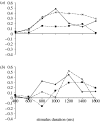The time-emotion paradox
- PMID: 19487196
- PMCID: PMC2685815
- DOI: 10.1098/rstb.2009.0013
The time-emotion paradox
Abstract
The present manuscript discusses the time-emotion paradox in time psychology: although humans are able to accurately estimate time as if they possess a specific mechanism that allows them to measure time (i.e. an internal clock), their representations of time are easily distorted by the context. Indeed, our sense of time depends on intrinsic context, such as the emotional state, and on extrinsic context, such as the rhythm of others' activity. Existing studies on the relationships between emotion and time suggest that these contextual variations in subjective time do not result from the incorrect functioning of the internal clock but rather from the excellent ability of the internal clock to adapt to events in one's environment. Finally, the fact that we live and move in time and that everything, every act, takes more or less time has often been neglected. Thus, there is no unique, homogeneous time but instead multiple experiences of time. Our subjective temporal distortions directly reflect the way our brain and body adapt to these multiple time scales.
Figures







Similar articles
-
Time perception, emotions and mood disorders.J Physiol Paris. 2013 Sep;107(4):255-64. doi: 10.1016/j.jphysparis.2013.03.005. Epub 2013 Mar 29. J Physiol Paris. 2013. PMID: 23542546 Review.
-
The experience of time: neural mechanisms and the interplay of emotion, cognition and embodiment.Philos Trans R Soc Lond B Biol Sci. 2009 Jul 12;364(1525):1809-13. doi: 10.1098/rstb.2009.0025. Philos Trans R Soc Lond B Biol Sci. 2009. PMID: 19487184 Free PMC article.
-
How emotions colour our perception of time.Trends Cogn Sci. 2007 Dec;11(12):504-13. doi: 10.1016/j.tics.2007.09.008. Epub 2007 Nov 26. Trends Cogn Sci. 2007. PMID: 18023604 Review.
-
Emotion effects on timing: attention versus pacemaker accounts.PLoS One. 2011;6(7):e21829. doi: 10.1371/journal.pone.0021829. Epub 2011 Jul 20. PLoS One. 2011. PMID: 21799749 Free PMC article.
-
Emotional modulation of interval timing and time perception.Neurosci Biobehav Rev. 2016 May;64:403-20. doi: 10.1016/j.neubiorev.2016.03.003. Epub 2016 Mar 10. Neurosci Biobehav Rev. 2016. PMID: 26972824 Free PMC article. Review.
Cited by
-
Effect of food cues on time perception: influence of calories and diet control.Sci Rep. 2022 Nov 25;12(1):20342. doi: 10.1038/s41598-022-24848-5. Sci Rep. 2022. PMID: 36434088 Free PMC article.
-
Feel the Time. Time Perception as a Function of Interoceptive Processing.Front Hum Neurosci. 2018 Mar 6;12:74. doi: 10.3389/fnhum.2018.00074. eCollection 2018. Front Hum Neurosci. 2018. PMID: 29559902 Free PMC article.
-
Time perception and depressive realism: judgment type, psychophysical functions and bias.PLoS One. 2013 Aug 21;8(8):e71585. doi: 10.1371/journal.pone.0071585. eCollection 2013. PLoS One. 2013. PMID: 23990960 Free PMC article.
-
Temporal Processing of Joyful and Disgusting Food Pictures by Women With an Eating Disorder.Front Hum Neurosci. 2018 Apr 6;12:129. doi: 10.3389/fnhum.2018.00129. eCollection 2018. Front Hum Neurosci. 2018. PMID: 29681806 Free PMC article.
-
A study of emotional states in candidates undergoing the diagnostic process for COVID-19.Ind Psychiatry J. 2021 Jan-Jun;30(1):131-135. doi: 10.4103/ipj.ipj_26_21. Epub 2021 Jun 30. Ind Psychiatry J. 2021. PMID: 34483537 Free PMC article.
References
-
- Adolphs R. Neural systems for recognizing emotion. Curr. Opin. Neurobiol. 2002;12:169–177. doi:10.1016/S0959-4388(02)00301-X - DOI - PubMed
-
- Adolphs R., Tranel D., Damasio A.R. The human amygdala in social judgement. Nature. 1998;393:470–474. doi:10.1038/30982 - DOI - PubMed
-
- Allan L.G., Gibbon J. Human bisection at the geometric mean. Learn. Motiv. 1991;22:39–58. doi:10.1016/0023-9690(91)90016-2 - DOI
-
- Anderson M.J., Reis-Costa K., Misanin J.R. Effects of September 11th terrorism stress on estimated duration. Percept. Mot. Skills. 2007;104:799–802. doi:10.2466/PMS.104.3.799-802 - DOI - PubMed
-
- Angrilli A., Cherubini P., Pavese A., Manfredini S. The influence of affective factors on time perception. Percept. Psychophys. 1997;59:972–982. - PubMed
Publication types
MeSH terms
LinkOut - more resources
Full Text Sources

